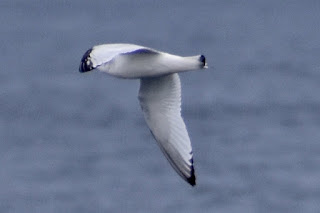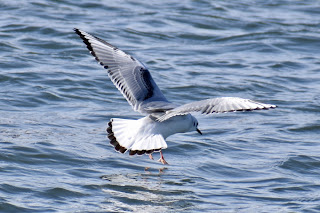Small Gull Identification in Winter
Along with the recent alcid irruption along New Jersey’s coast, there have been more than the normal sightings of small winter gulls from land. Four small gulls in particular are Bonaparte’s Gull, Black-headed Gull, Little Gull and Black-legged Kittiwake. The kittiwake is the only true pelagic gull of this group, so land-based sightings of these are special. In the adult breeding stage of the four gulls, kittiwake is easy to separate from the other three because it lacks a dark head. But in subadult stage, all four have a black spot of some sort behind the eye, all have tails with black tips and all sport an “M” pattern to varying degrees on their backs. Since this is the nonbreeding season, the focus here will be on nonbreeding, or basic, plumage.
Black-legged kittiwake is the least likely to be seen from land here. It is the largest of the four gulls, but that requires a direct comparison to the others. Its legs are black; the legs of the other three range from pink/pale to orange/red. A subadult has a dark spot behind the eyes like the other three, however it is the only one that has a dark half collar around the back of the neck. In flight, it has an “M” pattern on its back. The kittiwake’s pattern is bold but is the only one with all white on the outer portion of the upper wings. The nonbreeding adult is easier to separate from the other gulls as it is the only one with a yellow bill and a black triangle at the wingtips.
Bonaparte’s gulls are the most commonly seen of the four species. They are often seen in large flocks, and are often found inland. All ages of nonbreeding Bonaparte’s have a black spot or mark behind the eye. The sub adult has the “M” pattern on its back, but it is narrow and not as bold as with a kittiwake or little gull. The adults are the only one of the four with black trailing edges on the top and bottom of the primaries.
Black-headed gulls are a European and Asian species with limited nonbreeding range to the North Atlantic. Sightings are usually of an individual bird. Ironically, the black-headed gull’s alternate plumage hood is a chocolate brown, not black. That aside, it is very similar to the Bonaparte’s gull in basic plumage. Subadults share the less bold “M” pattern of the Bonaparte’s but are the only one of the four with all dark inner primaries. The black-headed gull can also be distinguished from the others with an orange to red bill and orange to red legs.
Last is the little gull. There is no smaller gull in the world. Little gull is mostly an Old World gull, recently expanding to North America. Little gull sightings are usually of individual birds, often associating with Bonaparte’s gulls. A nonbreeding adult is the only one of the four with all dark underwings. This feature can be striking in flight when it is mixed with Bonaparte’s. Adults also have white border on the top and bottom of the trailing edges of the wings and tip. The tips of the little gull have a rounded or blunt appearance. Unlike the others in the group, the little gull carries remnants of its breeding dark hood through the winter. This smudgy looking cap is found on all ages of the little gull. The “M” pattern on the first winter little gull is bold like a kittiwake, but also has dark secondaries. A second winter bird lacks the “M” pattern, but still has white border on the wings trailing edge and white wing tips.






















Comments
Post a Comment